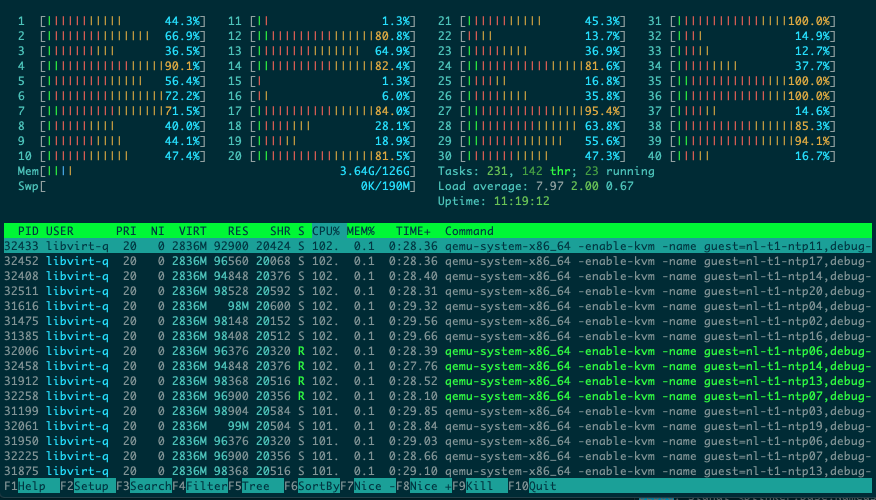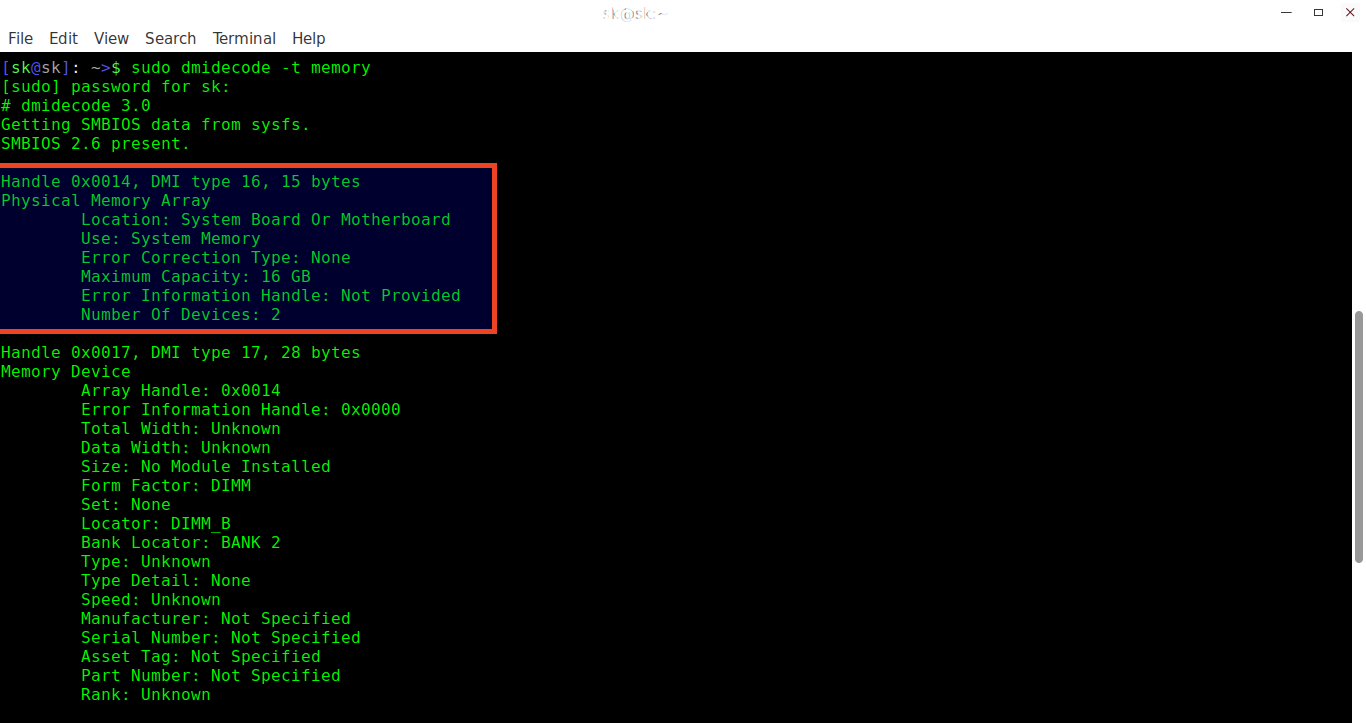Linux Command Memory Slots
Linux line commands enable you to gather all possible details about your computer's memory. You can even determine whether you can add extra memory to the computer without opening up the box. To list each memory stick and its capacity, issue the dmidecode command: dmidecode -t memory grep -i size. Check RAM on Linux using free. The most popular command in order to check your RAM on Linux is to use the “free” command. $ free total used free shared buff/cache available Mem: 40216 16 480 Swap: 0 0 0. A quick way to check memory slots on a Linux box July 19, 2012 Leave a comment Here’s a useful way of finding out how many memory slots are occupied on the motherboard of a machine without removing the cover, as well as how much installed physical memory is supported.
- Linux Command Memory Slots Games
- Linux Command To Check Memory Slots
- Linux Command Memory Slots Upgrade
- Linux Command Memory Slots Downloads
- Linux Command Memory Slots Windows 10
Finding RAM size details in Linux for a System admin is very easy task. We can use free command to check how much RAM is present in our system. But when you want to find how many RAM/Memory sa lots are present in your system is bit tricky one. One way to do open your system and check what sa lots are there and how much RAM. Instead of doing this as a Hardware engineer we can use a command to check which sa lot is having below details.
- How much RAM
- Speed of the RAM
- Maximum RAM supported by that machine
- RAM location etc.
As you are already aware of dmidecode command to get all the system hardware info. We will use the same command for getting our RAM details.
To Find RAM details like maximum RAM, location of RAM etc we can use -t option with dmidecode as shown below
dmidecode -t 16
Output:

# dmidecode 2.11
SMBIOS 2.7 present.
Handle 0x000F, DMI type 16, 23 bytes
Physical Memory Array
Location: System Board Or Motherboard
Use: System Memory
Error Correction Type: None
Maximum Capacity: 16 GB
Error Information Handle: No Error
Number Of Devices: 2
If you see the above output we can figure it out how much maximum RAM this machine support, number of RAM devices and location etc.
To get actual RAM details such as how many sa lots, actual RAM present etc, use -t 17 option in dmidecode command
dmidecode -t 17
Output:
# dmidecode 2.11
SMBIOS 2.7 present.

Handle 0x0010, DMI type 17, 34 bytes
Memory Device
Array Handle: 0x000F
Error Information Handle: 0x0011
Total Width: 64 bit’s
Data Width: 64 bit’s
Size: 4096 MB
Form Factor: SODIMM
Set: None
Locator: DIMM0
Bank Locator: BANK 0
Type: DDR3
Type Detail: Synchronous
Speed: 1333 MHz
Manufacturer: Kingston
Serial Number: 4B29A74B
Asset Tag: 0123456789
Part Number: 99U5428-046.A00LF
Rank: Unknown
Configured Clock Speed: 1333 MHz
Handle 0x0013, DMI type 17, 34 bytes
Memory Device
Array Handle: 0x000F
Error Information Handle: 0x0014
Total Width: 64 bit’s
Data Width: 64 bit’s
Size: 4096 MB
Form Factor: SODIMM
Set: None
Locator: DIMM1
Bank Locator: BANK 2
Type: DDR3
Type Detail: Synchronous
Speed: 1333 MHz
Manufacturer: Kingston
Serial Number: 4729BF4B
Asset Tag: 0123456789
Part Number: 99U5428-046.A00LF
Rank: Unknown
Configured Clock Speed: 1333 MHz
If we want to see complete RAM details we can use -t memory option to get the details. Note this is a combination of 16 and 17 options
dmidecode -t memory
Output:
# dmidecode 2.11
SMBIOS 2.7 present.
Handle 0x000F, DMI type 16, 23 bytes
Physical Memory Array
Location: System Board Or Motherboard
Use: System Memory
Error Correction Type: None
Maximum Capacity: 16 GB
Error Information Handle: No Error
Number Of Devices: 2
Handle 0x0010, DMI type 17, 34 bytes
Memory Device
Array Handle: 0x000F
Error Information Handle: 0x0011
Total Width: 64 bit’s
Data Width: 64 bit’s
Size: 4096 MB
Form Factor: SODIMM
Set: None
Locator: DIMM0
Bank Locator: BANK 0
Type: DDR3
Type Detail: Synchronous
Speed: 1333 MHz
Manufacturer: Kingston
Serial Number: 4B29A74B
Asset Tag: 0123456789
Part Number: 99U5428-046.A00LF
Rank: Unknown
Configured Clock Speed: 1333 MHz
Handle 0x0013, DMI type 17, 34 bytes
Memory Device
Array Handle: 0x000F
Error Information Handle: 0x0014
Total Width: 64 bit’s
Data Width: 64 bit’s
Size: 4096 MB
Form Factor: SODIMM
Set: None
Locator: DIMM1
Bank Locator: BANK 2
Type: DDR3
Type Detail: Synchronous
Speed: 1333 MHz
Manufacturer: Kingston
Serial Number: 4729BF4B
Asset Tag: 0123456789
Part Number: 99U5428-046.A00LF
Rank: Unknown
Configured Clock Speed: 1333 MHz
Some of the valid keywords/types you can use and find different details are as follows.
bios
system

baseboard
chassis
processor
memory
cache
connector
sa lot
We can even use lshw command to get RAM/Memory details as well Cache details such as L1, L2 and L3 levels.
lshw -class memory
*-firmware
description: BIOS
vendor: Hewlett-Packard
physical id: 0
version: F.22
date: 07/27/2011
size: 1MiB
capacity: 2496KiB
capabilities: pci upgrade shadowing cdboot bootselect edd int13floppynec int13floppytoshiba int13floppy360 int13floppy1200 int13floppy720 int13floppy2880 int9keyboard int10video acpi usb biosbootspecification uefi
*-memory
description: System Memory
physical id: f
sa lot: System board or motherboard
size: 8GiB
*-bank:0
description: SODIMM DDR3 Synchronous 1333 MHz (0.8 ns)
product: 99U5428-046.A00LF
vendor: Kingston
physical id: 0
serial: 4B29A74B
sa lot: DIMM0
size: 4GiB
width: 64 bit’s
clock: 1333MHz (0.8ns)
*-bank:1
description: SODIMM DDR3 Synchronous 1333 MHz (0.8 ns)
product: 99U5428-046.A00LF
vendor: Kingston
physical id: 1
serial: 4729BF4B
sa lot: DIMM1
size: 4GiB
width: 64 bit’s
clock: 1333MHz (0.8ns)
*-cache:0
description: L1 cache
physical id: 1c
sa lot: L1 Cache
size: 32KiB
capacity: 32KiB
capabilities: synchronous internal write-through instruction
*-cache:1
description: L2 cache
physical id: 1d
sa lot: L2 Cache
size: 256KiB
capacity: 256KiB
capabilities: synchronous internal write-through unified
*-cache:2
description: L3 cache
physical id: 1e
sa lot: L3 Cache
size: 3MiB
capacity: 3MiB
capabilities: synchronous internal write-through unified
*-cache
description: L1 cache
physical id: 1b
sa lot: L1 Cache
size: 32KiB
capacity: 32KiB
capabilities: synchronous internal write-through data
Do let us know if there is any way to find RAM sa lot details.
The following two tabs change content below.
- Docker: How to copy files to/from docker container - June 30, 2020
- Anisble: ERROR! unexpected parameter type in action:
Fix - June 29, 2020 - FREE: JOIN OUR DEVOPS TELEGRAM GROUPS - August 2, 2019
- Review: Whizlabs Practice Tests for AWS Certified Solutions Architect Professional (CSAP) - August 27, 2018
- How to use ohai/chef-shell to get node attributes - July 19, 2018
lspci stands for list pci. Think of this command as “ls” + “pci”.
This will display information about all the PCI bus in your server.
Apart from displaying information about the bus, it will also display information about all the hardware devices that are connected to your PCI and PCIe bus.
For example, it will display information about Ethernet cards, RAID controllers, Video cards, etc.
lspci utility is part of the pciutils package.
If you don’t have pciutilis, install it on your system as shown below.
1. Default Usage
By default it will display all the device information as shown below. The first field is the slot information in this format: [domain:]bus:device.function
In this example, since all the domain are 0, lspci will not display the domain.

Note: In all the examples below, we’ll be showing only partial output by picking couple of devices from the above list.
2. Dump PCI Info in Different Format
Linux Command Memory Slots Games
If you want to pass the output of the lspci command to a shell script, you may want to use -m option (or -mm option) as shown below.
This option is also helpful when you want to view the subsystem information. For example, for the RAID controller, the default output just says that is is using LSI Logic RAID controller. But, the following output displays the subsystem, which is DELL PERC H700 Integrated RAID controller system.
3. Output in Tree Format
The -t option will display the output in tree format with information about bus, and how devices are connected to those buses as shown below. The output will be only using the numerical ids.
4. Detailed Device Information
If you want to look into details of a particular device, use -v to get more information. This will display information about all the devices. The output of this command will be very long, and you need to scroll down and view the appropriate section.
Linux Command To Check Memory Slots
For additional level for verbosity, you can use -vv or -vvv.
In the following example, I’ve given output of only the RAID controller device.
5. Display Device Codes in the Output
If you want to display the PCI vendor code, and the device code only as the numbers, use -n option. This will not lookup the PCI file to get the corresponding values for the numbers.
If you want to display both the description and the number, use the option -nn as shown below.
6. Lookup a Specific Device
When you know the slot number in the domain:bus:slot.func format, you can query for a particular device as shown below. In the following example, we didn’t specify the domain number, as it is 0, which can be left out.
When you know the device number in the vendor:device format, you can query for a particular device as shown below.
Linux Command Memory Slots Upgrade
If you know only either the vendor id, or the device id, you can omit the other id. For example, both the following command will return the same output as the above.
7. Display Kernel Drivers
Linux Command Memory Slots Downloads
This is very helpful when you like to know the name of the kernel module that will be handling the operations of a particular device. Please note that this option will work only on Kernel 2.6 version and above.
Linux Command Memory Slots Windows 10
If you enjoyed this article, you might also like..
Next post: What is Cloud Computing? Introduction to Cloud Service Models
Previous post: How to Combine Ping and Traceroute On Linux Using MTR Command Examples